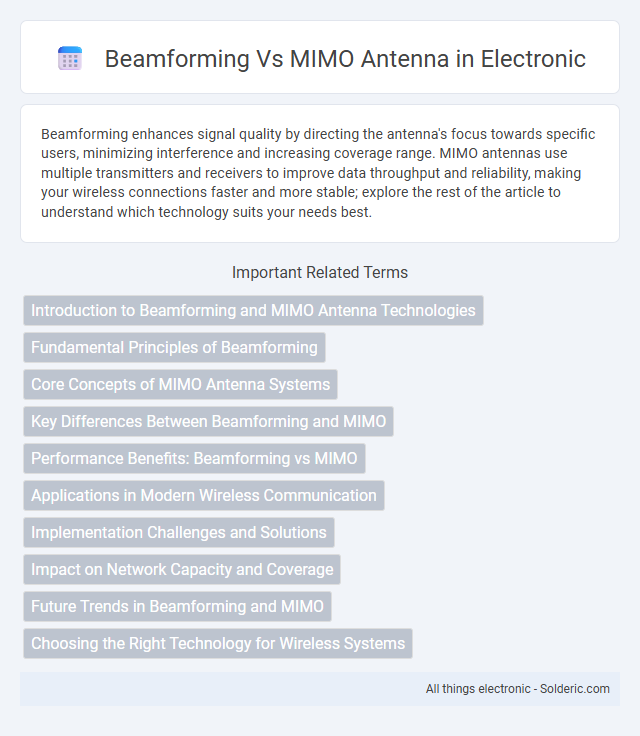Beamforming enhances signal quality by directing the antenna's focus towards specific users, minimizing interference and increasing coverage range. MIMO antennas use multiple transmitters and receivers to improve data throughput and reliability, making your wireless connections faster and more stable; explore the rest of the article to understand which technology suits your needs best.
Comparison Table
| Feature | Beamforming | MIMO Antenna |
|---|---|---|
| Definition | Signal processing technique that directs signal beams to specific users. | Multiple Input Multiple Output technology using multiple antennas for simultaneous data streams. |
| Primary Purpose | Enhance signal strength and reduce interference. | Increase data capacity and spectral efficiency. |
| Number of Antennas | Typically multiple antennas for directional beam control. | Multiple antennas for transmitting and receiving multiple data streams. |
| Signal Improvement | Focuses signal energy toward target receiver. | Utilizes spatial multiplexing for higher throughput. |
| Complexity | Moderate signal processing complexity. | Higher complexity due to multiple data streams and antenna coordination. |
| Use Cases | Improving coverage and signal quality in wireless networks. | Enhancing data rates and network capacity in 4G/5G systems. |
| Benefits | Better signal-to-noise ratio (SNR) and reduced interference. | Increased throughput and reliability via spatial diversity. |
Introduction to Beamforming and MIMO Antenna Technologies
Beamforming and MIMO antenna technologies enhance wireless communication by improving signal quality and data throughput. Beamforming directs signal energy towards a specific user or device, optimizing your wireless coverage and reducing interference. MIMO (Multiple Input Multiple Output) uses multiple antennas at both the transmitter and receiver ends to simultaneously send and receive data streams, significantly increasing network capacity and reliability.
Fundamental Principles of Beamforming
Beamforming technology utilizes an array of antennas to direct radio waves toward a specific target, enhancing signal strength and reducing interference by adjusting the phase and amplitude of the transmitted signals. Unlike MIMO (Multiple Input Multiple Output), which relies on multiple independent data streams sent and received through multiple antennas to increase capacity and reliability, beamforming focuses on spatial filtering to optimize signal delivery in a targeted direction. Fundamental to beamforming is the manipulation of signal phase alignment across antenna elements to create constructive interference at the desired angle, significantly improving communication quality in wireless networks.
Core Concepts of MIMO Antenna Systems
MIMO antenna systems utilize multiple antennas at both the transmitter and receiver to exploit spatial diversity, enhancing signal reliability and capacity. Core concepts include spatial multiplexing, where independent data streams are transmitted simultaneously, and spatial diversity, which improves signal quality through multiple propagation paths. Beamforming focuses signal energy in specific directions, while MIMO emphasizes leveraging multiple antennas to optimize overall communication performance through complex signal processing.
Key Differences Between Beamforming and MIMO
Beamforming enhances signal quality by directing radio waves toward a specific user, improving range and reducing interference, while MIMO (Multiple Input Multiple Output) uses multiple antennas to simultaneously transmit and receive multiple data streams, increasing data throughput and reliability. Beamforming focuses on spatially filtering signals to enhance signal-to-noise ratio, whereas MIMO exploits multipath propagation to maximize spectral efficiency. Key differences include beamforming's role in signal directionality and interference management, compared to MIMO's capacity for parallel data transmission and improved network capacity.
Performance Benefits: Beamforming vs MIMO
Beamforming technology enhances signal strength and coverage by directing the antenna's energy toward specific users, resulting in improved signal quality and reduced interference. MIMO (Multiple Input Multiple Output) leverages multiple antennas to transmit and receive multiple data streams simultaneously, significantly increasing data throughput and spectral efficiency. Compared to beamforming, MIMO offers superior performance benefits in high-density environments by enabling spatial multiplexing, while beamforming excels in improving link reliability and extending coverage range.
Applications in Modern Wireless Communication
Beamforming enhances signal strength and coverage by directing wireless signals toward specific users, significantly improving efficiency in 5G networks and Wi-Fi 6 applications. MIMO (Multiple Input Multiple Output) technology increases data throughput and spectral efficiency by utilizing multiple antennas for simultaneous transmission and reception, vital for LTE and future 5G NR deployments. Both beamforming and MIMO are integral to modern wireless communication systems, optimizing network capacity, reducing interference, and enabling high-speed, reliable connections for IoT devices, smartphones, and smart city infrastructures.
Implementation Challenges and Solutions
Beamforming and MIMO antenna systems face implementation challenges such as complex signal processing and hardware design for precise beam steering and spatial multiplexing. Solutions include advanced algorithms for adaptive beamforming, real-time channel estimation, and the integration of low-latency digital signal processors to optimize performance. Your network can benefit from combining these technologies with robust calibration techniques and scalable architectures to overcome interference and deployment difficulties.
Impact on Network Capacity and Coverage
Beamforming enhances network capacity and coverage by directing signal energy toward specific users, reducing interference and improving signal strength. MIMO antenna technology increases capacity through spatial multiplexing, allowing multiple data streams to be transmitted simultaneously over the same frequency band. Your network performance benefits from the combination of beamforming's targeted signal focus and MIMO's efficient spectrum utilization, resulting in higher throughput and extended coverage areas.
Future Trends in Beamforming and MIMO
Future trends in beamforming emphasize enhanced spatial resolution and adaptive algorithms to support 5G and 6G networks, enabling ultra-reliable low-latency communication and massive machine-type connectivity. MIMO technology advances with massive MIMO, leveraging hundreds of antennas to improve spectral efficiency and energy efficiency in wireless networks. Integration of beamforming with MIMO systems drives smart antenna arrays, optimizing signal quality, interference management, and network capacity for next-generation wireless infrastructures.
Choosing the Right Technology for Wireless Systems
Beamforming enhances signal directionality by focusing wireless signals towards specific devices, improving range and reducing interference. MIMO (Multiple Input Multiple Output) employs multiple antennas to transmit and receive simultaneous data streams, increasing throughput and reliability. Your choice depends on network requirements: beamforming excels in targeted coverage, while MIMO optimizes capacity in high-traffic environments.
beamforming vs MIMO antenna Infographic

 solderic.com
solderic.com